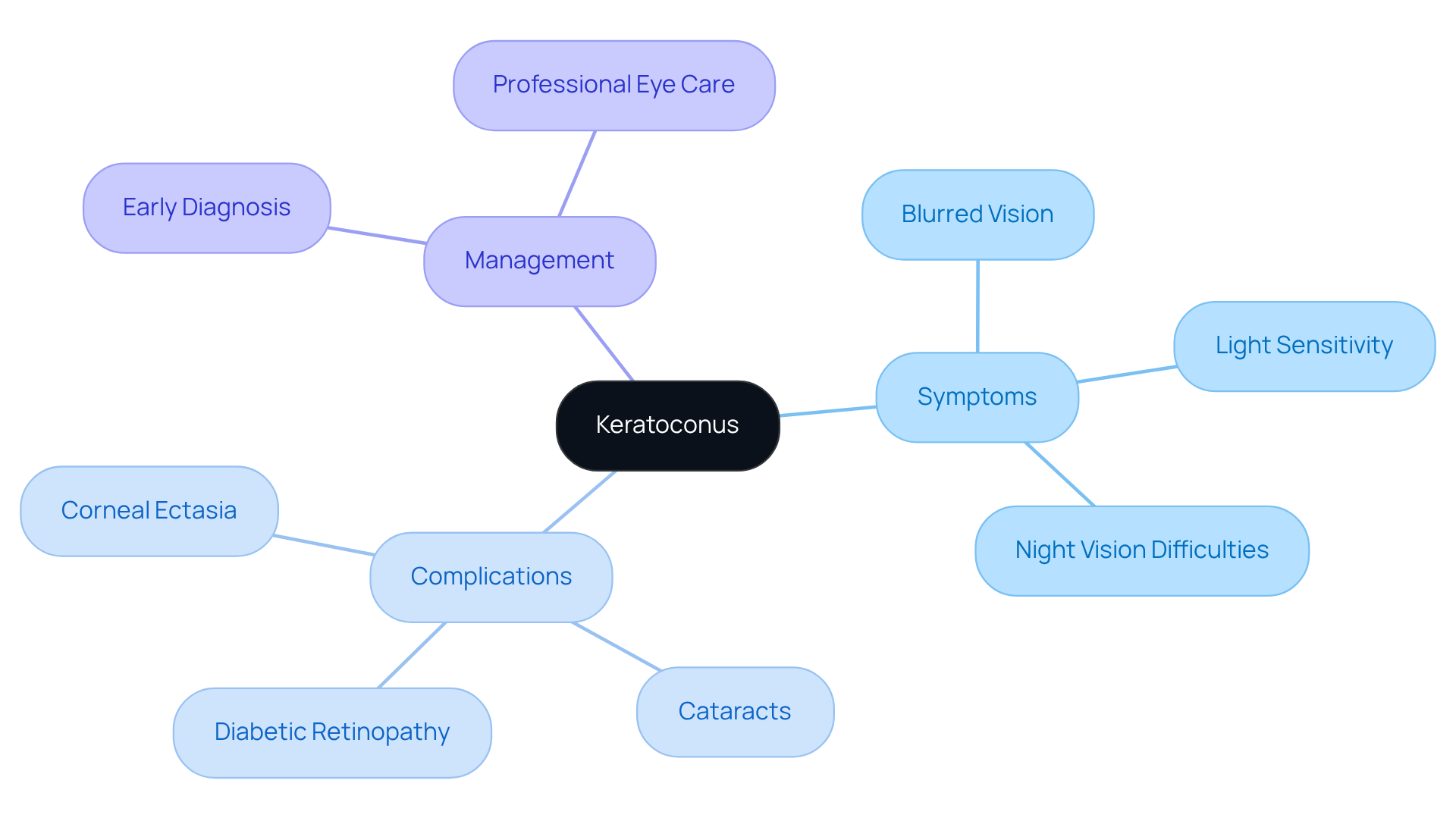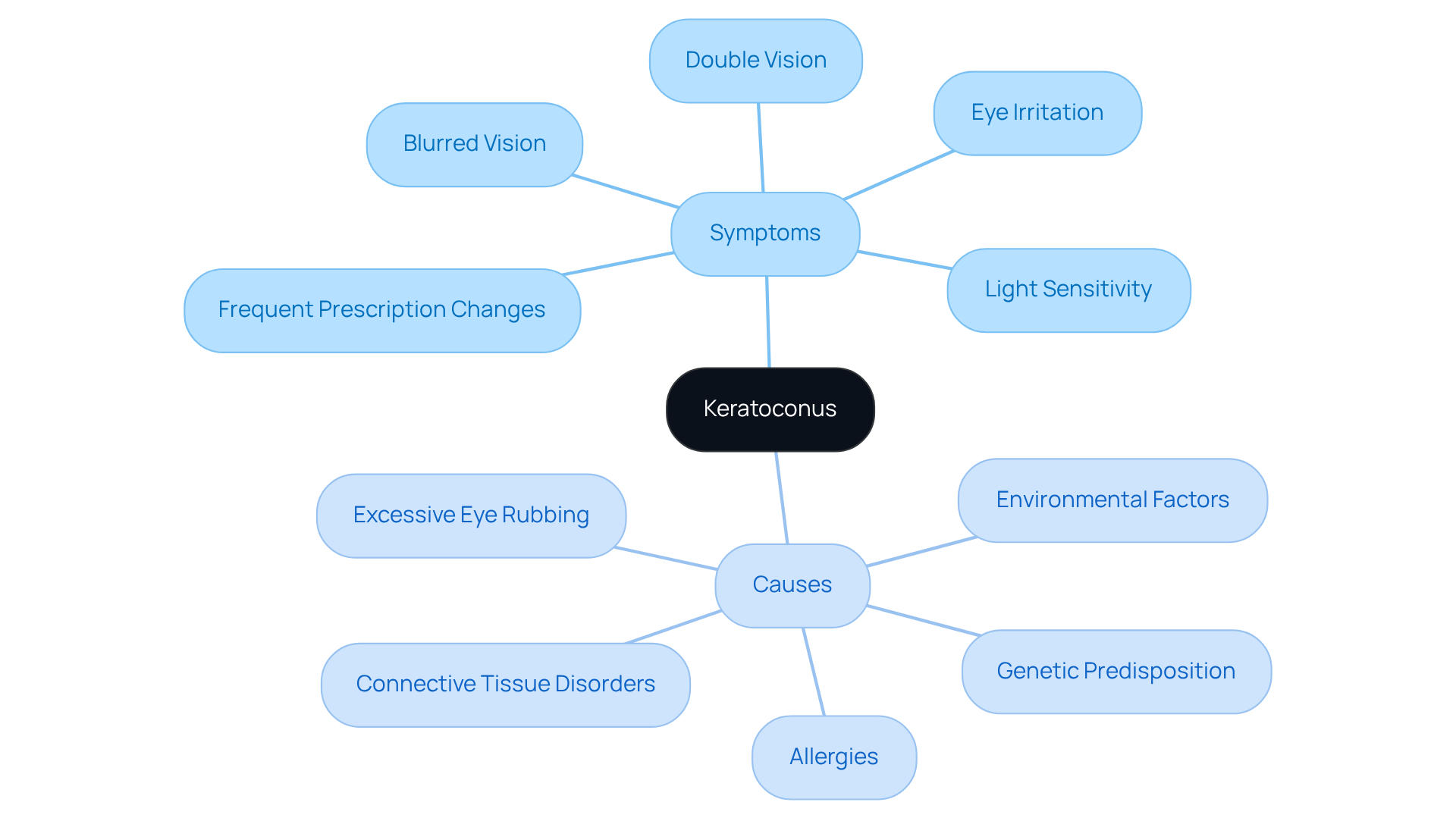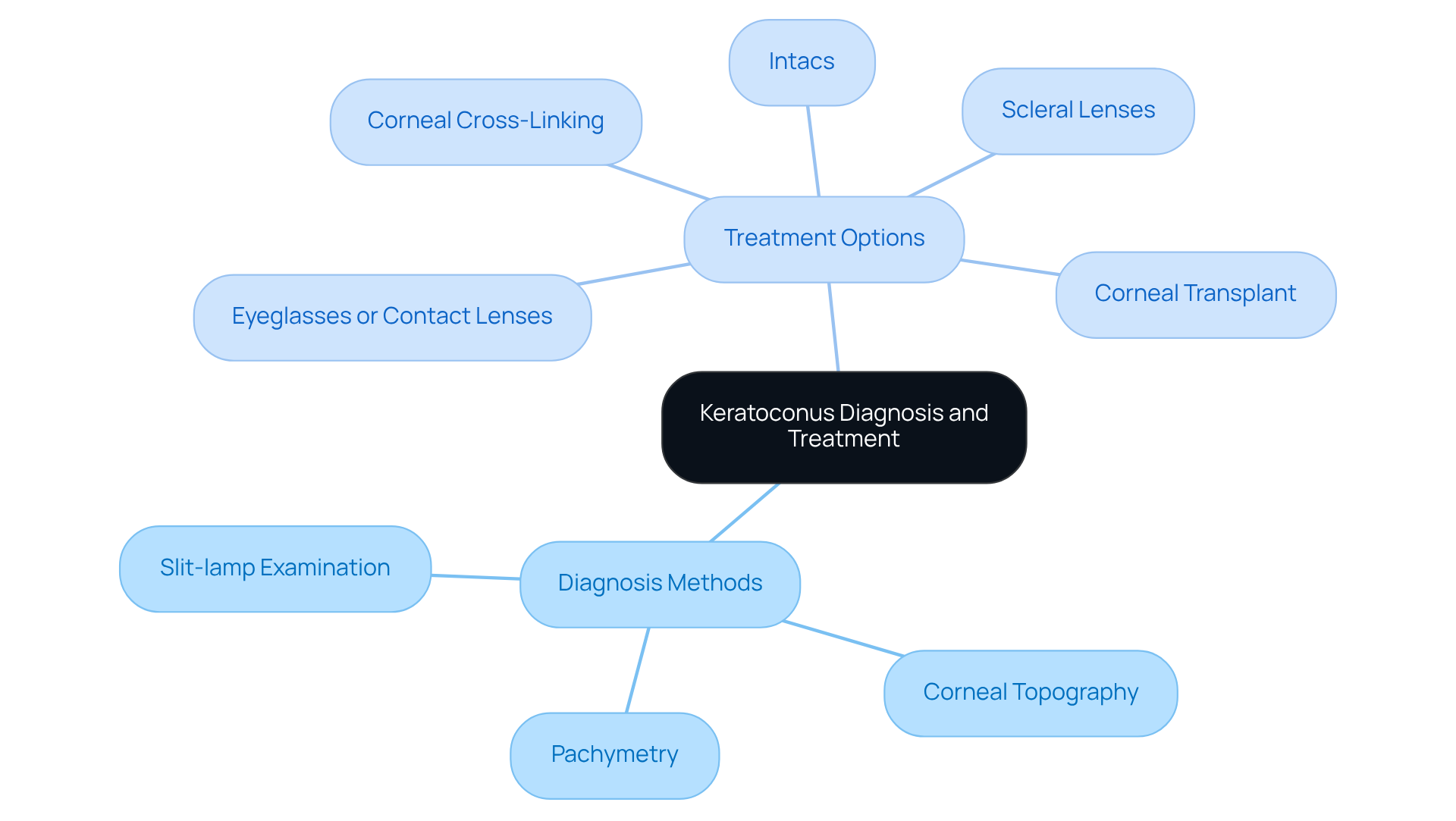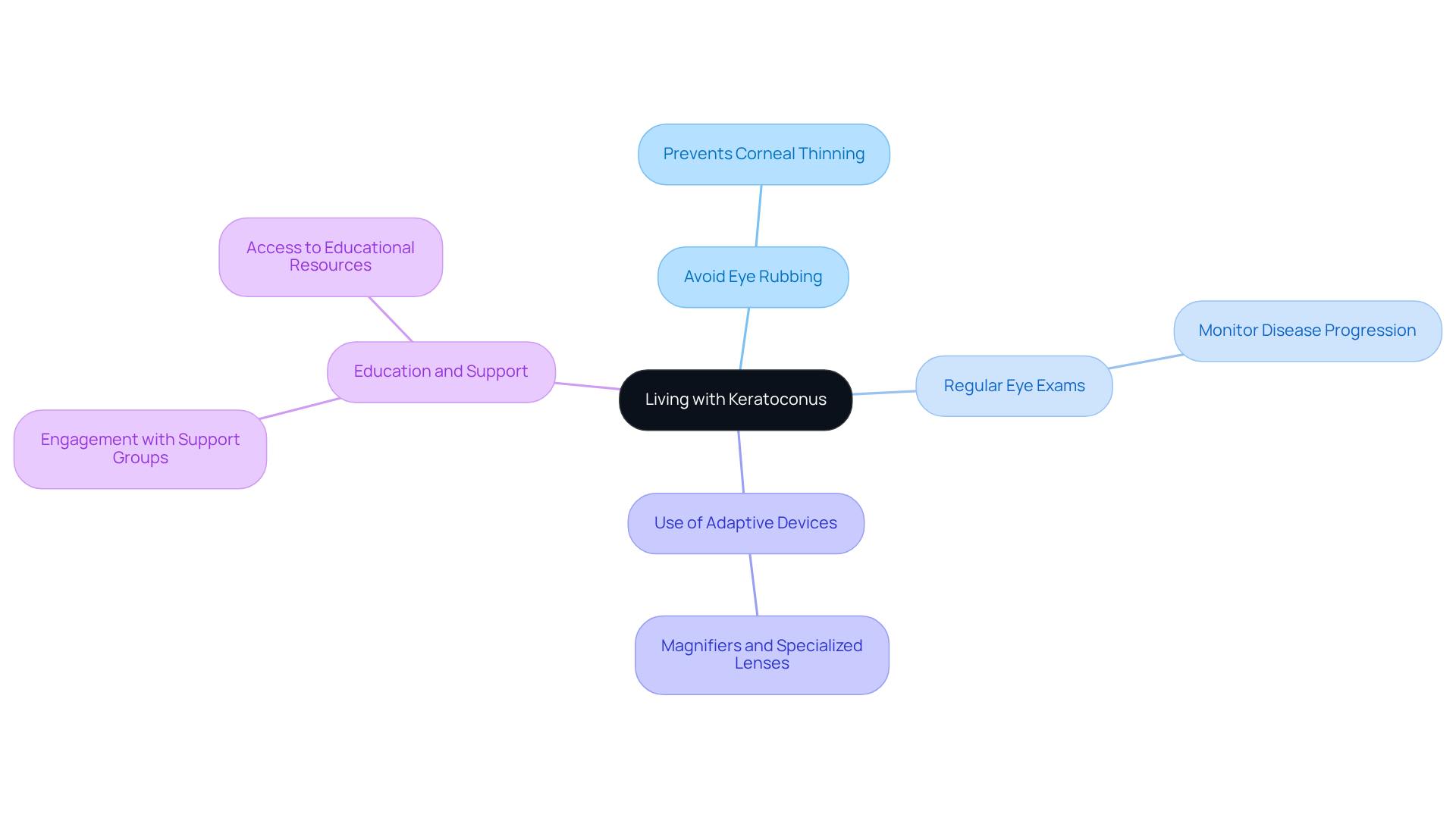Posted by: Northwest Eye in General on October 14, 2025
Overview
Keratoconus is a progressive eye condition that can be concerning, as it involves the thinning and protrusion of the cornea. This can lead to distorted vision, causing symptoms such as blurred sight, light sensitivity, and difficulties seeing at night. We understand that these changes can be distressing, and it’s important to know that early diagnosis and management options are available.
There are various ways to maintain your vision quality. Options include specialized lenses and surgical procedures that can help you navigate the challenges associated with this condition. We encourage you to explore these options, as they can significantly improve your visual experience and overall well-being.
Remember, you are not alone in this journey. Many individuals have successfully managed keratoconus and found comfort and support through their treatment. We are here to help you through this process, ensuring that you have the information and resources needed to make informed decisions about your care.
Introduction
Keratoconus presents a unique challenge for those affected, altering the very essence of vision through the thinning and protrusion of the cornea. We understand that this condition can lead to distorted sight and increased sensitivity to light, complicating daily activities and impacting overall quality of life.
By understanding the symptoms, diagnosis, and available treatment options, individuals can feel empowered to navigate this journey with confidence. It’s common to feel overwhelmed, but there are ways to effectively manage the complexities of keratoconus and ensure a fulfilling life despite its impacts.
Define Keratoconus and Its Impact on Vision
Keratoconus is a progressive eye condition that can be concerning. It is characterized by the thinning and protrusion of the eye’s surface, which takes on a cone-like shape rather than its usual dome shape. This alteration in the cornea’s structure can lead to significant distortions in keratoconus vision. You might experience keratoconus vision, which includes symptoms like:
- Blurred and warped vision
- Increased sensitivity to light
- Difficulties seeing at night
We understand that such changes can be alarming. Distorted eyesight may arise from various irregularities, including:
- Corneal ectasia
- Cataracts
- Diabetic retinopathy
These can indicate the presence of other eye disorders. As keratoconus vision progresses, it can significantly impact your ability to carry out daily activities. That’s why early diagnosis and management are crucial for maintaining your vision quality.
Symptoms such as halos around lights and glare, particularly during nighttime driving, can further complicate your keratoconus vision experience. Typically, this condition begins in adolescence and may continue to progress into your 30s, often affecting both eyes unevenly.
At Northwest Eye, we are here to help you through this process. We emphasize the importance of and education to empower you to understand your symptoms and explore your treatment options. Remember, you are not alone in this journey, and we are committed to supporting you every step of the way.

Identify Symptoms and Causes of Keratoconus
Common symptoms of keratoconus can be concerning, and we want to help you understand them better. These may include:
- Blurred or distorted vision that is not easily corrected with glasses. This can also indicate other conditions, such as cataracts or diabetic retinopathy.
- Increased sensitivity to light and glare, particularly during night driving. You might notice that can make this experience even more challenging.
- Frequent changes in eyeglass prescriptions due to deteriorating eyesight, highlighting the importance of regular eye examinations.
- Double vision or ghosting of images, which can significantly impact your daily activities.
- Eye irritation or discomfort, often worsened by eye rubbing. This habit may also contribute to the progression of keratoconus.
We understand that the precise reason for keratoconus remains unclear. It is thought to involve a combination of genetic predisposition and environmental factors. Conditions like allergies, excessive eye rubbing, and connective tissue disorders may play a role in the progression of this eye condition. Understanding these symptoms and causes is crucial for both patients and healthcare providers, as it facilitates early diagnosis and appropriate management. Remember, you are not alone in this journey, and we are here to help you through it.

Explore Diagnosis and Treatment Options for Keratoconus
Understanding the diagnosis of keratoconus vision is a crucial step in addressing your concerns. A comprehensive eye examination typically involves several important methods:
- Slit-lamp examination: This allows your ophthalmologist to observe the shape and thickness of your cornea, providing vital insights.
- Corneal topography: This imaging technique charts the surface curvature of your eye’s outer layer, helping to identify any irregularities.
- Pachymetry: This test measures the thickness of your outer layer, which is essential for assessing the severity of keratoconus vision.
We understand that navigating treatment options can feel overwhelming, especially when considering the severity of your condition. Here are some possibilities:
- Eyeglasses or contact lenses: In the early stages, many find that vision can often be corrected with specialized lenses, offering a sense of normalcy.
- Corneal cross-linking (CXL): This minimally invasive procedure strengthens corneal tissue, helping to halt progression and providing reassurance.
- Intacs: These small, curved implants are placed into the surface of your eye to reshape it and enhance your sight.
- Scleral lenses: These large-diameter lenses vault over the cornea, offering a smooth optical surface that can improve comfort and vision.
- Corneal transplant: In more advanced cases, a corneal transplant may be necessary to restore your vision and quality of life.
Grasping these diagnostic techniques and treatment alternatives is essential for effectively managing your condition. Remember, we are here to help you through this process, ensuring you feel supported every step of the way.

Understand Prognosis and Living with Keratoconus
The outlook for individuals with can vary significantly, depending on the severity of the condition and how quickly treatment is sought. We understand that this can be a concerning time. With suitable management, many patients can preserve good sight and maintain a quality life. However, it’s important to recognize that untreated corneal disease can lead to significant impairment of keratoconus vision and, in some cases, legal blindness.
Living with keratoconus often requires certain lifestyle adjustments. Here are some key recommendations:
- Avoid eye rubbing: This can exacerbate the condition and accelerate corneal thinning.
- Regular eye exams: Frequent check-ups with an eye care professional are essential to monitor the progression of the disease.
- Use of adaptive devices: Magnifiers or specialized lenses can help improve daily functioning.
- Education and support: Engaging with support groups or educational resources can provide emotional support and practical advice for managing the condition.
By understanding the prognosis and implementing effective management strategies, individuals can lead fulfilling lives despite the visual challenges posed by keratoconus vision. Remember, we are here to help you through this process.

Conclusion
Keratoconus is a progressive eye condition that significantly alters the structure of the cornea, leading to various vision problems. We understand that navigating this condition can be challenging, and recognizing its symptoms is essential for early diagnosis and effective management. By acknowledging the potential impact on daily life, individuals can seek the necessary care and support to maintain their vision quality.
Throughout this article, we have outlined key aspects of keratoconus, including symptoms such as:
- Blurred vision
- Increased light sensitivity
Alongside its causes and diagnostic methods. Treatment options, ranging from specialized lenses to surgical interventions, have been discussed, highlighting the importance of tailored management strategies. Moreover, the prognosis for individuals living with keratoconus shows that with appropriate care, many can lead fulfilling lives despite the challenges posed by this condition.
Ultimately, proactive engagement in eye health, including regular check-ups and education about keratoconus, is vital. We encourage individuals to seek professional guidance and support, as this can significantly enhance their quality of life and visual outcomes. By taking these steps, those affected by keratoconus can navigate their journey with confidence and resilience.
Frequently Asked Questions
What is keratoconus?
Keratoconus is a progressive eye condition characterized by the thinning and protrusion of the eye’s surface, resulting in a cone-like shape instead of the usual dome shape.
How does keratoconus affect vision?
Keratoconus can lead to significant distortions in vision, including symptoms such as blurred and warped vision, increased sensitivity to light, and difficulties seeing at night.
What are some additional symptoms associated with keratoconus?
Other symptoms may include halos around lights and glare, particularly during nighttime driving.
What other eye disorders can be related to keratoconus symptoms?
Distorted eyesight in keratoconus may arise from various irregularities, including corneal ectasia, cataracts, and diabetic retinopathy.
When does keratoconus typically begin and how does it progress?
Keratoconus usually begins in adolescence and may continue to progress into a person’s 30s, often affecting both eyes unevenly.
Why is early diagnosis and management important for keratoconus?
Early diagnosis and management are crucial for maintaining vision quality, as the condition can significantly impact daily activities as it progresses.
How can Northwest Eye assist individuals with keratoconus?
Northwest Eye emphasizes the importance of professional eye care and education to help individuals understand their symptoms and explore treatment options, providing support throughout the process.






